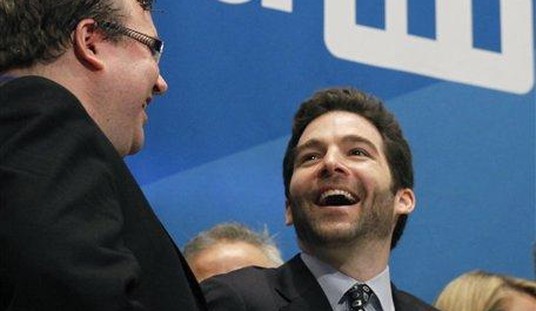We finally found a poll result more depressing than Andrew Cuomo’s surprisingly resilient approval rating.
The social cost of closed schools is a running theme on the site this morning and not just because Ed, Jazz, and I think alike. Even big media, normally allied with Democratic priorities, has grown impatient with the slow pace of school reopenings and begun to look more skeptically at the arguments behind them. It was Jake Tapper, not a Fox News host, who put CDC chief Rochelle Walensky through the wringer on her agency’s hyper-cautious guidance on reopening a few weeks ago. And it was Pro Publica that published the piece Ed wrote about this morning describing the ruinous effect prolonged school closures has had on teenagers’ well-being.
Has any of that affected Democratic opinion, though? Yesterday I wrote about how the debate over mask mandates is really just an argument over one’s comfort with marginal changes in risk. Risk-tolerance varies from person to person but it’s also influenced by ideology. In the aggregate, Republicans have been consistently more willing to reduce pandemic restrictions and accept a higher risk of infection than Democrats have, an approach liberals would describe as “anti-science.” But after all the data showing how low the risk of infection is inside schools, and all the reporting describing the emotional and developmental damage done to children by a year away from class, what other term should we use to describe the last result here?

Seventy-four percent support for limiting restaurants to carry-out service only — i.e. no indoor dining at all, whatever that may mean for the industry’s bottom line — is also draconian but at least there’s data to support the perception of risk in that case. In the case of schools, the latest numbers from Brown University’s ongoing study of infections among students and staff reveal that schools once again posed less risk to adults who work in them over the second half of February than their surrounding communities did. The numbers for the first half of February looked like this:
Community: 43 positive tests per 100,000 people
School staff: 30 per 100K
Students: 21 per 100K
In the second half of February, all three groups saw lower rates of confirmed cases:
Community: 26 per 100K
School staff: 17 per 100K
Students: 11 per 100K
School staff were less likely to test positive in the second half of the month than students were in the first half. That’s how safe schools are right now with the pandemic (temporarily?) receding. And yet, after nearly a year of some public-school students being kept out of class, a supermajority of Democrats continue to believe school closures are necessary to contain COVID.
One way to interpret that is to read the Q&A narrowly. Maybe some Dems understood the question as asking them whether they think school closures would help contain the virus rather than whether that help justifies keeping them shuttered. That is, some of the 66 percent may believe it’s sufficiently important to open schools that we should do it even though closures are “necessary” to lowering infection rates. More likely, though, is that this issue has been consumed by mindless partisan polarization, beginning with Trump making school reopenings a rallying cry late last summer and continuing with the Biden administration’s conspicuously tentative outlook on getting schools open ASAP. If Trump was gung ho to do it and Biden’s not gung ho to do it, that’s all some Dems may need to know to conclude that schools should stay shut as a matter of prudence. WaPo noticed last week that, for all the lip service paid by Team Joe to reopening classrooms, they’ve been much less organized about it than they’ve been about ramping up vaccines:
Others close to the administration, however, said the plan for schools reopening was a little more nebulous than the others [for vaccines]. “It was partly thought through” when Biden announced it on Dec. 8, said one official familiar with the conversations, speaking on the condition of anonymity to share a candid assessment, but “not all the way.”…
Allen, the Harvard professor, said the changing explanations [about whether schools would be considered “open” or not] confused many. “The administration so far has not done a good job on messaging around schools,” he said. “Schools are confused, parents are confused, and this country still doesn’t have a clear plan on how to get kids back.”…
Another challenge was the lack of a clear Biden administration point person tasked solely with helping to open schools. The Post spoke with more than 30 education and public health groups in touch with the administration on the issue, and many remained unclear who was overseeing schools reopening. One top ally said health officials, rather than education officials, seemed to be taking the lead.
Rank-and-file Dems may have read that signal of lower priority for reopenings by the White House and felt newly confident in their own complacency. But in the end, their reluctance to reopen may be more a product of lefties feeling greater risk-aversion on average (towards COVID specifically or in general) than Republicans feel. Black and Latino parents in particular have been reluctant in polling to send kids back to class, knowing how disproportionately lethal COVID has been to minorities. And don’t forget that, for all of the righteous conservative outrage at teachers unions, many Americans have been supportive of how those groups have handled the pandemic as well. On that note, I’ll leave you with this sinister revelation from last night. People who are worried about infection shouldn’t be traveling for vacation, right?
NEW: In a leaked post from a private Facebook group for UTLA union members only, teachers are warned not to post on social media if they go on spring break vacations because the optics would be bad for them while UTLA is refusing to return to "unsafe" in-person schooling @FOXLA pic.twitter.com/KxQc7k450T
— Bill Melugin (@BillFOXLA) March 9, 2021








Join the conversation as a VIP Member